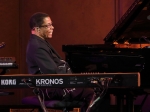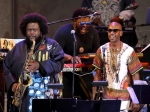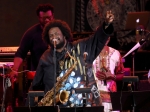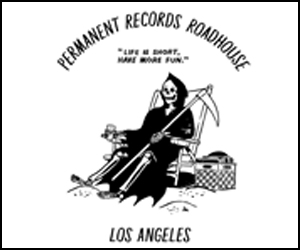Jazz by the dozens: Herbie Hancock, Kamasi Washington celebrate community at the Bowl
Steve Hochman on
0

Only two names graced the Hollywood Bowl marquee Wednesday: headliner Herbie Hancock and opener Kamasi Washington. But the way the night played out, there should have been 53 — Hancock, plus the four members of his band, and Washington’s monumental four-dozen-strong cadre. It was a night devoted to the truly collaborative, expansive nature of the best jazz (however you define “jazz”) and to the power and pleasures of community, to the delight both of the nominal leaders and the audience.
For much of the time he was on stage Wednesday, Hancock looked as if he was having the time of his life. And that is really saying something, considering the life he’s had. Much of that life was considered here, a musical life in which the keyboard maestro has been a Blue Note young lion of the ’60s, a forceful fusioneer in the ’70s and keytar-wielding funkster in the ’80s, a classical recitalist and classic jazz revivalist, and now, at 77, a seemingly indefatigable statesman of jazz. All of that was covered by him and his powerful, nimble four-man band in the set’s first piece alone, fittingly titled “Overture.”
It was no mere pastiche of Hancock’s various phases and stages, but a newly woven tapestry from all those threads. It also served to showcase both the individual and collective talents of the musicians who joined him: guitarist Lionel Loueke’s astonishingly inventive ways are rooted in his upbringing in the West African nation Benin to the outer reaches of avant-jazz, and drummer Vinnie Colaiuta and bassist James Genus provide the rare combinations of force and restraint. And newest member Terrace Martin, on keys and sax, showed himself both a student of jazz (which informed his groundbreaking work producing Kendrick Lamar’s “To Pimp a Butterfly”) and advocate for the kind of currency that Hancock, the Los Angeles Philharmonic’s Creative Chair for Jazz, continues to embrace with passion.
That opening was masterful, Hancock and band shifting from style to style, mood to mood, sometimes deftly and others abruptly, even jarringly. It’s hard to say if that was all mapped out or in the moment, though it seemed to be some of both, and it was as brilliant as the big smile on Hancock’s face. And, yeah, it even ended with a bit of “Rockit,” his barriers-breaking, and just plain fun, early-’80s hip-hop/funk MTV hit.
More often than not, this ensemble and set most closely echoed the electro-space-jazz Hancock made with his early-’70s Mwandishi outfit, matched with the crisp funk power of its successor, Headhunters. It was a masterful set, marred only by some meandering in the middle — Hancock and Martin might want to cut back on the vocoder noodling, though Loueke’s electronically altered guitar and voice (the latter digitally split into a massive chorus incorporating traditional African clicks and pops as well as singing) is ever-impressive. And, yes, the keytar came out, Hancock taking to his feet to joyously trade licks with Martin on sax. Closing the set with his 1964 soul-jazz evergreen “Cantaloupe Island,” Hancock and band again spanned the eras with élan, and the encore of the rubbery Headhunters hit “Chameleon” sent fans into the night dancing and whistling.
For Washington, “The Epic” isn’t just the title of his breathtaking, three-hour 2015 album, but a way of artistic life. That was manifest here as the tenor sax man blended his group (including his proud dad, Rickey, on soprano sax and flute, and several other scene stars including pianist Cameron Graves and bassist Miles Mosley) with a full strings section and chorus, as well as in the many streams coursing through the compositions. And yet, it never got unwieldy or messy, nor clinical or academic, all of the elements and sensibilities represented working together — a spectacle in all the best ways. And, sonically speaking, pretty sexy, too. And even more than Hancock did, Washington kept the spotlight on his cohorts rather than himself, all about community.
Community was clearly on his mind. He noted at the start that Terrace Martin (they grew up together, and Washington played a key role on “Butterfly” too) reminded him that it was during a Hamilton High band performance on this very stage at which Washington decided he wanted to be a professional jazz musician.
That was explicit in the live premier of “Truth,” from his upcoming “Harmony of Difference” EP. This extended work combines elements of a five-piece suite created in collaboration with filmmaker A.G. Rosas and painter Amani Washington, Kamasi’s sister, commissioned by the Whitney Museum of American Art. Washington introduced it by touting how “blessed” he feels to have grown up amid the many cultures found in Los Angeles.
“It’s not something to tolerate,” he said, pointedly. “It’s something to celebrate.”








Leave a Reply